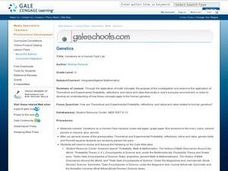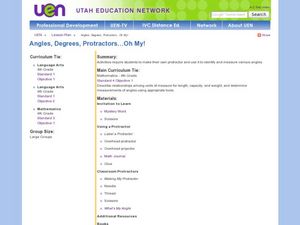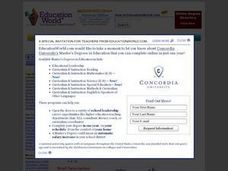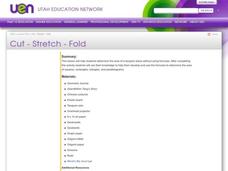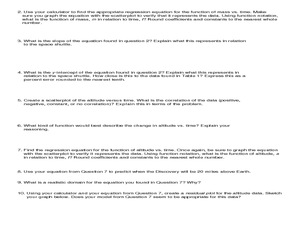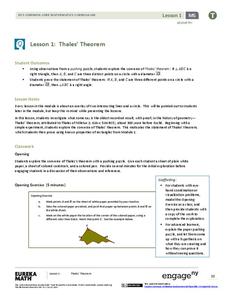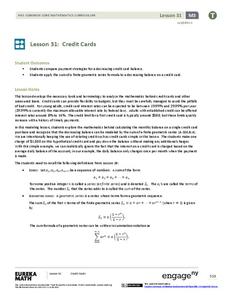Curated OER
Saving Strawberry Farm
Students explore U.S. History by analyzing the Great Depression. For this economic instability lesson, students read fictitious accounts of a farm dealing with the loss of a Strawberry Farm and discuss the reasons behind the loss....
Curated OER
Discovering Math Concepts in Advanced Algebra
Young scholars explore the concept of Chinese contributions in mathematics. In this Chinese contributions in mathematics lesson, students research Chinese achievements in mathematics. Young scholars solve 3x3 systems of equations using...
Curated OER
Pythagorean Theorem Word Problems
Students investigate the concept of the Pythagorean Theorem for geometry by using word problems. The challenge is for them to translate the words into the right measurements for a triangle looking for the longest side known as the...
Curated OER
Mathematicians and Scientists Treasure Hunt
Students match a fact with a mathematician or scientist using the Internet. They read about a mathematician or scientist that happens to be female or a person of color.
Curated OER
Nickels, History, and Peace
Second graders examine the designs on nickels before 2004 and after when the new Peace Medal nickel was minted. They research the events that preceded the new design and explore the symbols of friendship on the new coin. They work in...
Curated OER
Prime Hunt On The Internet
Eighth graders find information about primes on the Internet. They use directions for Sieve of Eratosthenes to find primes in the first 100 numbers. After a lecture/demo, 8th graders access a website imbedded in this plan to explore...
Curated OER
Hurricanes in History:
Students interpret data displayed in a graph, make inferences based on graphical data. They work in pairs or groups to interpret graphs containing historical data of hurricanes, and then answer questions that assess their understanding...
Curated OER
Language Arts: Women in History
Learners read excerpts from Amelia Earhart's autobiography, "The Fun if It," and identify her character traits. To aid visualization of her transatlantic flight, they search books and the Internet for photos related to Earhart's flights....
Curated OER
Variations on a Human Face Lab
Ninth graders gain an application level understanding of probability, symmetry, and ratios and rates that exists in one's everyday environment relative to human genetics.
Curated OER
Heroes and Heroines: King David, Julius Caesar, Cleopatra and Napoleon
Students identify and examine four heroes from history and imaginative literature. They discuss the characteristics of a hero and share perceptions of what makes a hero. By comparing and analyzing a few historical and literary figures,...
Curated OER
Understanding: Computing
Students examine how a pebble calculator works and compare it to an abacus. After a discussion on the abacus and pebble calculator and how each works, they construct their own pebble calculators. They determine how to represent...
EngageNY
Why Do Banks Pay YOU to Provide Their Services?
How does a bank make money? That is the question at the based of a lesson that explores the methods banks use to calculate interest. Groups compare the linear simple interest pattern with the exponential compound interest pattern.
Curated OER
The "Wright" Puzzle
A crossword puzzle based on the lives of the Wright brothers. Students research on their own or in small groups several brief biographies of the Wright brothers.They complete a crossword puzzle based on their reading.
Curated OER
Dino-Myte Spreadsheet
Do your learners like dinosaurs and theme parks? An ambitious lesson invites learners to put together a plan for supplying dinosaurs for a new theme park. Pupils work together in groups to come up with their plan, which must include a...
National Research Center for Career and Technical Education
Transportation, Distribution, and Logistics: Tire and Wheel Assemblies
Is bigger really better? By the end of this lesson, learners will be able to apply formulas for computing the diameter of tires and wheel assemblies. Begin by showing a slide presentation that will review definitions for radius and...
EngageNY
Why Were Logarithms Developed?
Show your class how people calculated complex math problems in the old days. Scholars take a trip back to the days without calculators in the 15th installment of a 35-part module. They use logarithms to determine products of numbers and...
Curated OER
Algebra...Your Second Language
Help learners translate word problems into algebraic equations. They will rewrite words using symbols and evaluate algebraic expressions using real life scenarios, animation sequences, video presentations, and activities to help young...
Utah Education Network (UEN)
Angles, Degrees, Protractors . . . Oh My!
Fourth and fifth graders make a protractor and identify various angle types. In this protractor and angle lesson, learners make their own protractor and use it to measure a variety of angles. They complete worksheets while identifying...
EngageNY
Exponential Growth—U.S. Population and World Population
Show how exponential growth can look linear. Pupils come to understand the importance of looking at the entire picture as they compare the US population to the world population. Initially, the populations look linear with the same rate...
Curated OER
Broken-Heart Matching Game
Learners use this fun game to practice, reinforce, or apply a wide variety of skills around Valentine's Day. Each students receives half a heart with zig-zag cuts made of pink construction paper with a piece of information. Their job is...
Curated OER
Area of Tangram Pieces
Mathematicians calculate the area of a tangram piece without using formulas. They use a geometry journal to record activities during this instructional activity. They make a set of tangrams and use them to...
Curated OER
Linear and Quadratic Model, Data Modeling
Students model quadratic and linear equations. In this algebra lesson, students solve word problems using equations. They create scatter plots and make predictions using correlations.
EngageNY
Thales’ Theorem
Isn't paper pushing supposed to be boring? Learners attempt a paper-pushing puzzle to develop ideas about angles inscribed on a diameter of a circle. Learners then formalize Thales' theorem and use geometric properties to develop a proof...
EngageNY
Credit Cards
Teach adolescents to use credit responsibly. The 32nd installment of a 35-part module covers how to calculate credit card payments using a geometric series. It teaches terminology and concepts necessary to understand credit card debt.
Other popular searches
- History of Mathematics
- Math History
- Black History Month Math
- History of Mathematics India
- The History of Mathematics
- Basic Facts Math History
- Math History Biography
- Women History and Math
- Math History & China
- Roman Numerals Math History
- History Discrete Mathematics
- Math History Root Words








